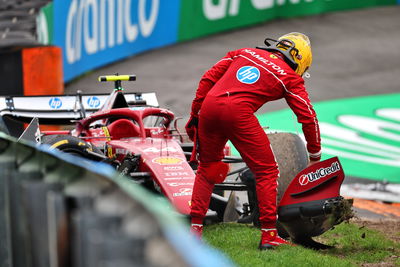Lewis Hamilton was slapped on a fifth-place grid penalty by Formula 1 stewards for violating the yellow flag rules before the Dutch Grand Prix began on Sunday.
The Ferrari star hit with two penalty points on his license while heading towards the grid and entering the pit lane.
Marshall was waving a double yellow flag at the banked final corner to ensure the safety of mechanics and others stationed on the starting grid before the race.
Steward pointed out that Hamilton had slowed him down, but considering the conditions he was still too fast.
The Steward also said he “didn’t think the driver had dropped “significantly” in speed at which he entered the pit entry road.”
So Hamilton will take on the fifth place grid penalty for the next race he will be participating in, Ferrari’s home round at Monza.
“The data showed that the driver was in the double yellow sector about 20kph less than his speed at the same time in the actual session, reducing throttle applications in a 10% to 20% order, and lifting them up 70 meters ahead once they entered the pit lane,” the statement read.
“We didn’t think a 20kph drop in speed in the double-wave yellow sector would “significantly” slow down. They also did not take into account speeds that “significantly” reduced the speed at which the driver entered the pit entry load. ”
The penalty exacerbates a tough weekend for Hamilton, who was unable to finish the race after crashing in Turn 3, when the rain began to intensify.
Full Lewis Hamilton Verdict

Hamilton kept the piece picked up after crashing.
“The Steward heard from the driver of the team (Lewis Hamilton), who was the team representative and measured/marshaled the system’s data, video, timing, telemetry, team radio and in-car video evidence.
“Because of the nature of the track, the race director has informed all participants that the last corner in front of the pit lane will waving a double yellow flag.
“This was to ensure the safety of people in the grid and pit lanes. Regulations require drivers passing through the double-wave yellow flag marshaling sector “to significantly reduce speed…”.
“We looked into the telemetry available within the FIA system and also asked the team to provide telemetry data to the team.” This took time and resulted in delays in this decision.
“In addition, Article 44.1 requires that all drivers covering multiple reconnaissance laps drive pit entry loads at “a massively reduced speeds.”
“The data showed that the driver was in the double yellow sector about 20kph less than his speed at the same time in the actual session, reducing throttle applications in order of 10% to 20%, and then lifted 70 meters ahead and braked when he entered the pit lane.
“We didn’t think a 20kph drop in speed in the double-wave yellow sector would “significantly” slow down. They also did not consider the speed at which the driver entered the pit entry load to be “significantly” lower.
“Penalty guidelines for such breaches usually attract penalties for 10 grid positions in the next race. But given the drivers tried to slow down speed and brake early, we mitigated that the mitigation situation and penalized five grid locations.
“We recall that our competitors have the right to appeal a particular Steward decision within the applicable time limits, pursuant to Article 15 of the FIA International Sports Code and Chapter 4 of the FIA Judicial and Disciplinary Rules.”
Charles Leclerc escapes sanctions from George Russell Clash
Meanwhile, the Steward took no action against Hamilton’s teammate, Charles Leclair, as he moved to Mercedes driver George Russell in 12 turns.
Leclerc took fifth place on lap 32, 72nd lap, Leclerc passed Russell, and made contact as the two drivers left Chicane.
Russell initially complained that Leclerc had completed the outside of the truck, but Ferrari’s driver insisted he had no space.
In their verdict, the Steward said, “The available evidence was inconclusive as to whether Car 16 left the truck. Representatives from both teams agreed that there was no clear evidence that Car 16 left the truck.”
Russell was also independently investigated for the same collision, but the steward concluded it was a race incident.
Four F1 drivers were cleared after the post-race investigation
Additionally, Max Verstappen, Carlos Sainz, Lando Norris and Nico Hulkenberg were all cleared after exceeding the 1M26S time limit between the reconnaissance lap safety car lines.
The steward explained that they would follow the Delta time for all the laps and only retreat when the other drivers shut their backs and overtake them. So they concluded that they weren’t driving “unnecessarily slow.”
“However, in all cases, the stewards determined that the drivers had taken appropriate action to prevent them from hindering others. In all cases, they slowed significantly to ensure that the other drivers passed while giving them a clear truck,” the statement read.
“The steward therefore decides that all drivers involved do not drive “unnecessarily slowly” and have exceeded the maximum time due to the appropriate action being taken, and therefore not taking any further action.


